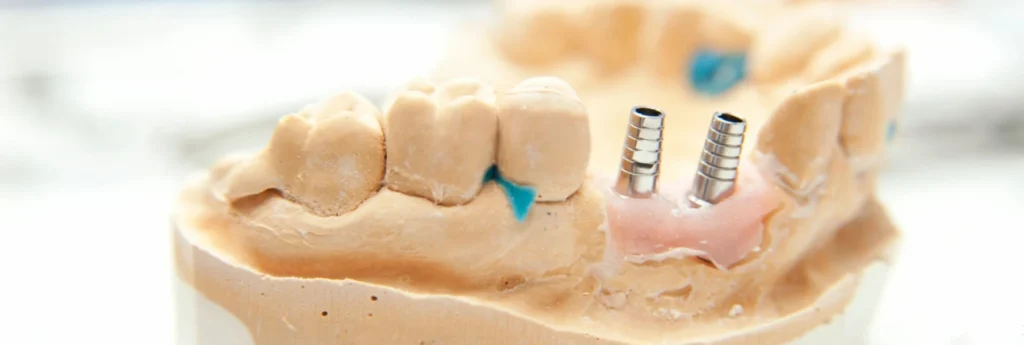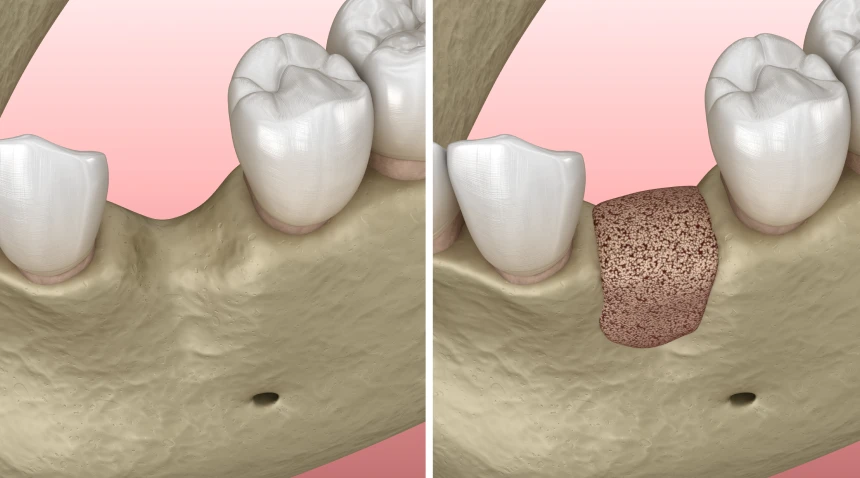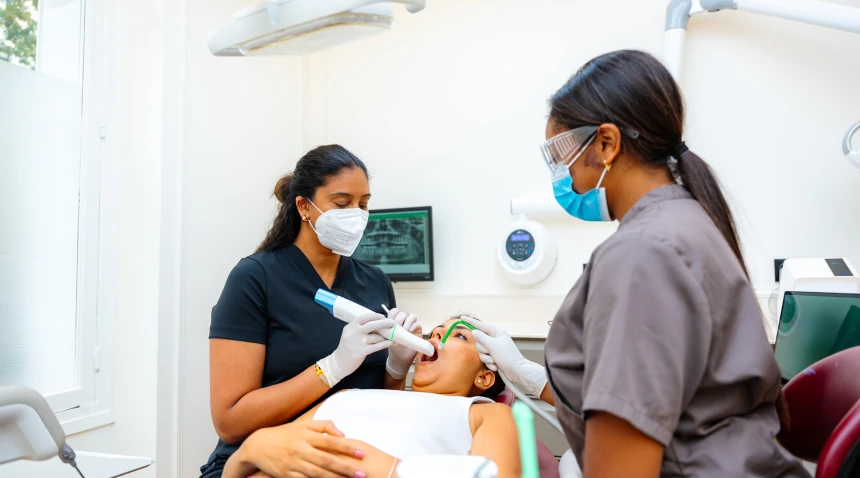Bone grafting is a surgical procedure that restores or increases the amount of bone in the jaw. It becomes necessary when the existing bone structure can no longer provide sufficient support for natural teeth or a dental implant. The dentist adds a graft — either from the patient or another source — to recreate a stable and long-lasting foundation.
Bone loss is a common phenomenon. It can result from tooth extraction without replacement, periodontal disease, trauma, or simply the natural aging process. Without mechanical stimulation, the alveolar bone — the bone that surrounds and supports the teeth — gradually resorbs. This process affects not only the possibility of placing an implant but also facial harmony and chewing function.
By restoring the jaw’s shape and density, bone grafting plays a key role in maintaining oral health and ensuring the success of restorative dental treatments.

Why consider a bone graft
There are many situations in which a bone graft may be necessary. The most common is preparation for dental implant placement. For an implant to integrate successfully and last over time, it must be anchored in healthy, high-quality bone. When the bone is too thin or too shallow, grafting becomes essential.
In addition, bone grafting is part of the treatment of severe periodontal disease, which progressively destroys the supporting bone around the teeth. Bone reconstruction helps stabilize the dentition and improve overall oral health.
After an accident or significant trauma, a graft may also be used to repair a fractured or deformed area. In some cases, it can also enhance the fit and comfort of removable dentures when bone resorption is too advanced.
The different types of bone grafts
The choice of technique depends on the amount of bone to be restored, the location, the patient’s general health, and the treatment goals. The main options are:
- Autogenous graft: bone taken from the patient (chin, jaw, etc.), perfectly compatible and promoting natural regeneration.
- Allogeneic graft: human bone from a tissue bank, sterilized and requiring no second surgical site.
- Xenogeneic graft: bone from an animal source (often bovine), made biocompatible to serve as a structural support.
- Synthetic substitutes: laboratory materials that mimic natural bone and stimulate regeneration.

Each type has specific indications. The choice is made after a precise diagnosis and thorough discussion between the dentist and the patient.
The importance of diagnosis for successful treatment
Before any bone grafting procedure, a thorough diagnosis is essential to ensure success. The dental surgeon assesses oral health, bone density, and any potential infections. This analysis relies on clinical examination, panoramic X-rays, and often a 3D scanner.

This comprehensive assessment precisely identifies the cause of bone loss and evaluates the area to be treated. It guides the choice of the most suitable grafting technique and determines the amount of graft material required.
By establishing a clear and personalized diagnosis, the practitioner minimizes surgical risks, promotes better healing, and significantly increases the chances of long-term success.
This step also prepares the patient. The dentist explains the procedure, postoperative expectations, and aftercare instructions. This transparent communication builds trust and encourages better cooperation during the healing phase.
How the procedure is performed
Preparation always begins with a full assessment (clinical examination, panoramic X-rays, and 3D imaging) to visualize the area to be treated and select the most appropriate technique.
The main steps are:
- Local anesthesia: the area is numbed to ensure a painless procedure.
- Opening the gum: a small incision gives access to the bone.
- Placement of the graft: the grafting material is inserted into the area to be filled or reinforced.
- Stabilization: the graft is secured and sometimes covered with a protective membrane.
- Closure: the gum is repositioned and sutured.
- Healing: the graft gradually integrates with the existing bone over several months.
Thanks to this structured process, consolidation occurs under optimal conditions. Depending on the material used and the location, healing takes three to six months before proceeding to the next stage of treatment.
Bone grafting provides a solid foundation for future dental implants.
Postoperative care
After surgery, mild swelling, tenderness, or slight bruising may occur but will fade gradually.
To promote proper healing, it is recommended to:
- Maintain good oral hygiene, avoiding direct brushing of the treated area at first.
- Eat soft, lukewarm foods for the first few days.
- Avoid smoking and alcohol, as they slow down recovery.
- Refrain from intense physical activity.

Following these guidelines supports successful graft integration and reduces the risk of complications. Follow-up visits allow the dentist to monitor progress and make adjustments if needed.
Precautions and contraindications
Bone grafting may not always be possible immediately. Certain conditions — such as uncontrolled chronic diseases, bleeding disorders, or heavy smoking — may require special precautions.
The dentist evaluates general health, lifestyle, and oral hygiene before planning the surgery. In some cases, preliminary treatment or improved oral care may be recommended before performing the graft.
Preparation is therefore a key factor in long-term success.
Bone grafting FAQ
- Is bone grafting painful?
No. Local anesthesia ensures a painless procedure. After the surgery, any mild discomfort can be effectively managed with appropriate medication. - How long before an implant can be placed?
On average, between three and six months are needed for the bone to consolidate. - Can bone grafting be avoided?
In some cases, yes. Short or angled implants can sometimes be placed if there is enough remaining bone — but this depends on a thorough clinical evaluation. - What are the risks?
Complications are rare. They may include infection, partial graft resorption, or delayed healing. Regular follow-up appointments help prevent these issues.
Book an appointment
To find out whether bone grafting is suitable for your situation, you can book an appointment online. The Cabinet dentaire Mirabeau, located in Paris 16, welcomes you for a complete examination and personalized advice.
You may also like: Greffe de sinus